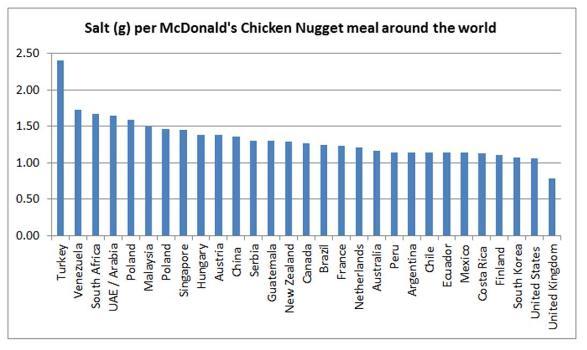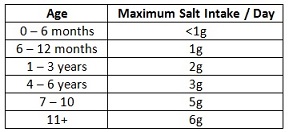New International Study Reveals Dangerously High Levels of Salt in Children’s Meals and Calls for Global Action NOW
- Eight out of ten (134/163) meals contain more than 1g salt per serving – that’s the max recommendation for a meal for a child aged 4-6 years [1].
- One meal contained as much salt as 10 packets of ready salted crisps (5.34g) [2].
- Over a year, a child in Costa Rica could be eating a WHOPPING 18 teaspoons (106.56g) MORE salt than a child eating the same meal in the UK [3].
- Too much salt in childhood habituates children to the taste of salt, and puts up blood pressure, which leads to strokes and heart failure.
International children meals survey data [PDF 603KB]
For Media Coverage: International Children's Meals Survey - Media Coverage
A NEW 2015 international children’s meals survey of 387 popular kid’s meal combinations carried out by World Action on Salt and Health (WASH) [1] reveals that children are being served worryingly high amounts of salt by popular fast food chains; with 82% (134/163) of meals containing more than 1g of salt. That’s more than a child aged 4-6 years old should be eating in one sitting [4], with some meals containing as much salt as 10 packets of ready salted crisps [2].
With over half of all meals (53%) containing more than half a days’ worth of salt for a 4-6 year old (1.5g), WASH is calling for ALL food manufacturers to universally reduce the salt content of their products, to help us achieve the global maximum target of 5g salt per adult per day [5] – with children’s meals taking priority – and saving lives!
The survey, the first of its kind looking at children’s meals sold from popular fast food chains, revealed the saltiest children’s meals around the world, highlighting, not only the excessive amounts of salt in these meals, but also the HUGE variation in salt contents of the same meals sold in different countries:
Table 1: Difference in highest and lowest salt content of popular children’s meals*

*based on available meal combinations for that country
For example, if a child in Costa Rica were to eat a KFC Popcorn Chicken meal (5.34g salt per serve) just twice a month [6] for a year they would be eating a WHOPPING 18 teaspoons of salt (106.56g) MORE than a child eating the SAME meal in the UK (0.9g salt per serve) [3].
Table 2: Variation of salt contents of a popular children’s meal around the world - McDonald’s Chicken Nuggets & Fries

The fact that these fast food chains are able to produce less salty children’s meals in some countries means they can do the same in ALL countries, and should immediately. All children, regardless of where they are from, should be able to enjoy the occasional meal out, as a treat, without putting their health at risk.” says Clare Farrand, Public Health Nutritionist and International Programme Lead at WASH.
“The more salt you eat as a child, the more likely you are to have serious health issues in later life.” Says Professor Graham MacGregor, Professor of Cardiovascular Medicine at Queen Mary University of London and Chairman of WASH. “This can include high blood pressure, increased risk of stroke, heart disease, osteoporosis and kidney disease. That is why it is vitally important that children do not get used to the taste of salt.”
Countries can learn from the UK’s successful salt reduction programme, which has set clear targets for the food industry to achieve, to gradually reduce salt added to processed food. As this is done slowly, people do not notice the difference in taste and there is no reduction in sales. Salt intake has fallen in the UK by 15% (between 2001-2011), and thousands of strokes and heart attacks are being prevented every year [7]. Without targets the food industry cannot be held to account for their contribution to the escalating global problem of strokes, heart attacks and heart failure and MUST now reformulate their products as a matter of priority. More recently, targets have been set for the out of home sector in the UK – which will reduce salt intakes even further – and have the potential to save even more lives. All countries should set targets for BOTH the out of home sector, and the food industry concurrently, to save the maximum number of lives.
Finally, of the 387 children’s foods choices WASH surveyed only 233 had complete nutritional information to allow comparison of salt contents.
“Lack of nutrition information makes it impossible for parents who are trying to do their very best to make a healthy choice for their children.” Says Stephanie Tucker, Nutritionist at WASH. “Therefore all fast-food restaurants should provide nutrition information, so that people can know exactly what is in their food.”
-ENDS-
Notes to editors:
National PR - David Clarke: david@rock-pr.com M: 07773 225516
Website: Welcome to World Action on Salt & Health
Tweet https://twitter.com/washsalt #LessSalt
[1] Survey details
- Salt per portion and per 100g information was collected from Burger King, KFC, McDonald’s and Subway’s own websites from February 2015. In country data was collected from March to June 2015.
- Data table sorted by highest salt per meal (g) in 2015
- Products translated from native language to English.
Criteria for selection: - must operate within at least 3 regions (for ease of analysis/accessibility of information)
- must have at least one widely consumed product
- must have at least one product/product equivalent that is comparable across countries
- must have nutritional information available on website/customer helpline
- local variations are avoided where possible for international relevance
[2] A standard 32.5g packet of Walkers Ready Salted Crisps in the UK contains 0.5g of salt. A KFC Popcorn Nuggets & Fries contains 5.34g salt per serve – 10.68 packets of ready salted crisps worth of salt.
[3] Comparing Costa Rica’s KFC Popcorn Nuggets and Fries (5.34g salt per serve) with the same meal sold in the UK (0.9g salt per serve): If eaten twice a month, over a year the amount of salt would total 128.16g and 21.6g respectively. This would equate to 21.36tsp of salt and 3.6 tsp. The difference between the two is 106.56g salt per year = 17.76 tsp salt (there are 6g salt in a teaspoon).
[4] Maximum Recommended Salt Intakes:
The daily recommended maximum amount of salt children should eat depends on their age. According to the Scientific Advisory Committee on Nutrition (SACN):

[5] World Health Organisation Guideline: Sodium intake for adults and children http://www.who.int/nutrition/publications/guidelines/sodium_intake_printversion.pdf
[6] The Soil Association’s Out to Lunch Report estimates in the UK, that 40% of parents eat out with their children at least once a fortnight
http://www.soilassociation.org/outtolunch
[7] He, F. J., Pombo-Rodrigues, S. & Macgregor, G. A. 2014. Salt reduction in England from 2003 to 2011: its relationship to blood pressure, stroke and ischaemic heart disease mortality. BMJ Open, 4, e004549


